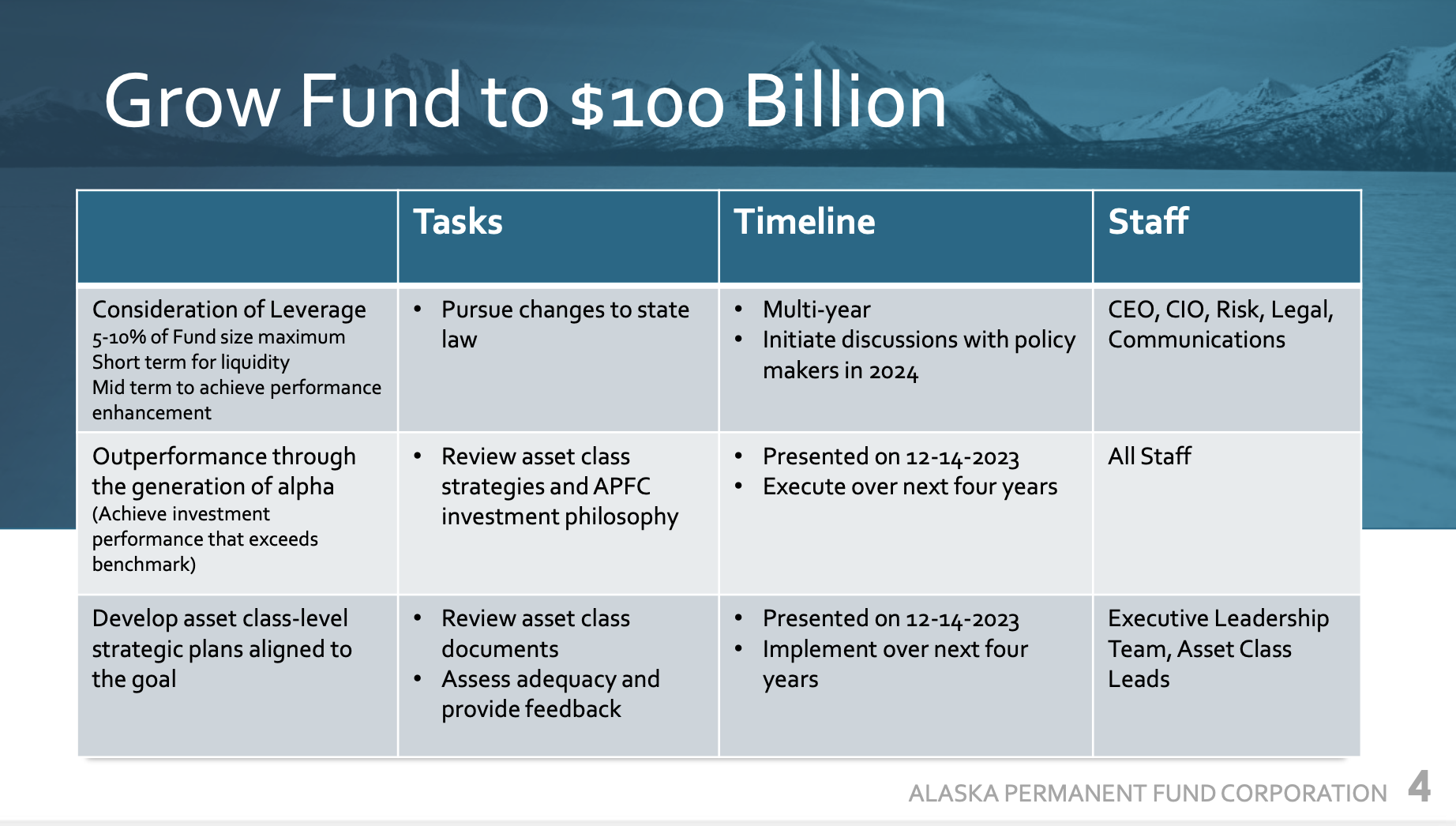Contradicting state documents, Permanent Fund trustees say they didn't plan to borrow billions for investments
Veteran Fairbanks attorney Barbara Schuhmann presented solid testimony to the Alaska Permanent Fund trustees last week about several elements of their proposed strategic plan. One of her points was that the fund should not pursue the idea of borrowing billions to generate higher returns.
This was at the start of the two-day meeting, when the proposed plan said the trustees wanted to be able to borrow 5 percent to 10 percent of the value of the fund, roughly $8 billion using the current value of the account.
It is disturbing that two trustees, Craig Richards and Gabrielle Rubenstein, were quick to claim that the fund did not want to borrow money to make investments, dressing up their comments with gibberish.
Contrary to their claims, the strategic plan memo released by the corporation to explain the plan to the public said that the borrowed money would be used for investments. Perhaps they failed to read their own report.
“By borrowing capital, with the objective of generating returns that surpass the borrowing cost over time, APFC could utilize leverage as a strategic investment decision,” the corporation told the public.
The borrowed money would be used for “short term for liquidity” and “mid term to achieve performance enhancement,” as part of the plan to speed growth of the fund to $100 billion.
Richards said the $100 billion goal was not a goal though that’s what it was when the trustees picked $100 billion as a goal last summer. They later backed off on making riskier investments and toned down the idea of borrowing money to make more money quickly.
Trustee Richards, a former attorney general under Bill Walker, is now also the Statehood Defense Coordinator for the Dunleavy administration, a contract job in which he helps decide what state lawsuits to file against the federal government.
It was Rubenstein who appeared in Saudi Arabia last fall and said “My baby has been our $100 billion strategic plan that we will hit over the next three to five years.”
Rubenstein, the daughter of one of the world’s richest men, was recruited by Dunleavy to serve as a trustee.
Richards said the $100 billion goal is now “like a marketing banner, like we get there when we get there and we’ll celebrate. And it’s something to talk about, but it’s not a goal in and of itself. It’s just something that when it happens, it will just show the growing up and maturing of the fund.”
Regarding the borrowing plan, he said the trustees reduced the amount they think the fund ought to try to borrow from what was discussed last fall.
“And the leverage package that we have currently in the strategic plan is really more of a credit facility so that we don’t have to sell off assets to make our cash calls. That’s the idea behind it, is that we have enough, you know, a couple billion dollars that Marcus (Marcus Frampton, the chief investment officer) can use to draw from in the short term so that we don’t have to liquidate assets to meet our cash demands,” said Richards.
This is not what the trustees told the public in writing about their plan.
The claim by Richards that it would only involve a couple of billion is contradicted by the clear proposal that it would be 5 percent to 10 percent of the value of the fund, $4 billion to $8 billion.
Rubenstein chimed in, saying there was a great misunderstanding about the plan to borrow billions and it was repeated throughout the public comments.
“We made a decision as a board to allow the public comment period to be much longer. And a lot of them say exactly what you’re saying,” said Rubenstein, referring to Schuhmann’s comments.
“But there’s a misunderstanding of what leverage would be used. We’re not borrowing to invest. But if you go follow what’s going on in other state legislatures, it goes back to what’s happened, which is less money was coming back from illiquid investments. And so Florida has, currently has a proposal right now to go get leverage so that they’re not selling off assets, I’ve heard that Wisconsin has it and California has it as well,” she said.
She said those states also have “very well established private equity programs that don’t want to not be able to harness some of the gains. So again, it’s not borrowing to invest, it’s being able to make the liquidity requirements that we have by state statute.”
Richards and Rubenstein made these comments on the first day of the two-day meeting, before the strategic plan had been amended to reduce the request to the Legislature for a borrowing authority of $4 billion.
I find it galling that Richards and Rubenstein claimed that members of the public didn’t understand the borrowing plan.
Your contributions help support independent analysis and political commentary by Alaska reporter and author Dermot Cole. Thank you for reading and for your support. Either click here to use PayPal or send checks to: Dermot Cole, Box 10673, Fairbanks, AK 99710-0673.
This is from the memo released by the corporation explaining the goal of growing the fund to $100 billion and the plan to borrow money for making investments. Trustees Craig Richards and Gabrielle Rubenstein said the idea of borrowing money was not to make investments, contradicting the information presented to the public.


